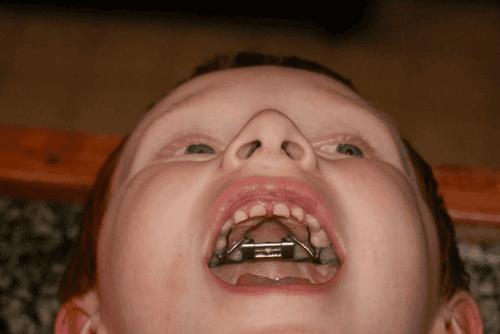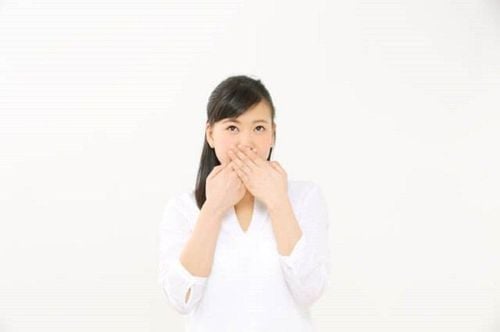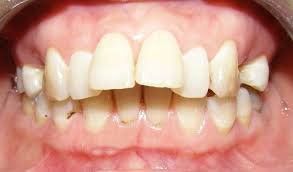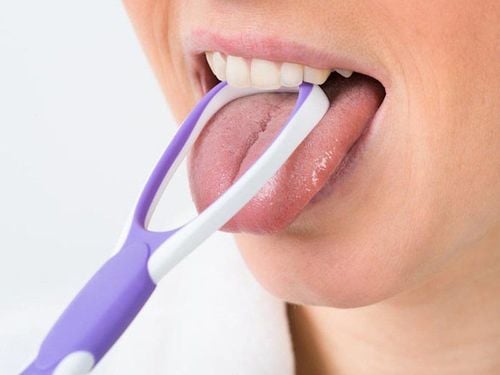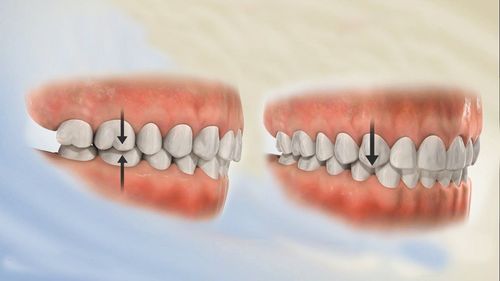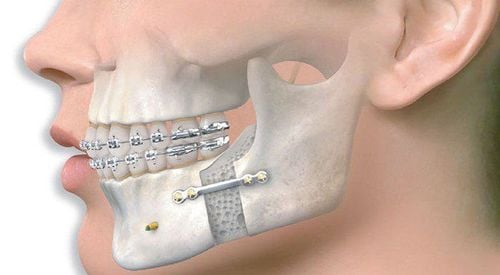This is an automatically translated article.
Raised bite in braces is a common indication for treatment of deep bite, open bite, crossbite,... So what is the effect of raised bite in braces? Let's find out through the article below.
1. What is occlusal lift?
Raise the bite for what? Raised bite is a therapy performed in parallel with wearing braces. When raising the occlusion, the synthetic bases will be placed on the molars or the back of the front teeth. These objects are inserted into the contact surface of the occlusal with the aim of preventing the jaws from fully reoccurring.
There are different reasons for doing this therapy. The main effect is to reduce the pressure that the lower jaw is subjected to due to deep or cross bites. In severe cases, this pressure can damage braces and enamel.
Raised bite braces is a support method of appliances to help teeth move faster and more smoothly. Doctors often prescribe occlusal lift for cases of crossbite or deep bite.
Then the doctors will put on the surface of the molars or front teeth (back) an occlusal lifter. In the case of wearing this appliance, your two teeth will not be able to touch each other, helping to minimize the impact and pressure on the lower jaw, and at the same time avoid damaging the enamel layer or damaging the brackets.
The reason is because when the bite is deep or crossbite, the lower jaw is subjected to great pressure from the upper jaw, distorting the relationship between the two chewing jaws. In addition, raising the bite is also a way to shorten the time of braces because this appliance has the ability to promote teeth to run faster, bringing higher efficiency.
2. The effect of raising the bite in braces
As mentioned above, occlusal lift is often used for patients with deep or crossbite conditions. In addition, the doctor can perform this procedure for patients who have a habit of grinding their teeth. To give the most appropriate and accurate regimen, the patient needs to be examined and x-rayed.
Deep bite:
Deep bite often manifests as the upper jaw covers and obscures the lower teeth when biting back normally. The upper jaw usually covers part or all of the lower jaw. In some cases, the bite is too deep, the edge of the lower teeth barely touches the upper teeth.
Instead, the edge of the tooth will touch the inner gum of the upper jaw. If this situation continues and is not intervened by lifting the bite, the patient's chewing function will be seriously impaired, and at the same time lose aesthetics and confidence when communicating.
In the case of orthodontics with braces, if the bite is not raised, the braces of the lower jaw will rub against the inner surface of the upper jaw, causing gum damage and reducing the effectiveness of treatment.
Crossbite :
Crossbite is also within the scope of treatment of occlusal lift. The most obvious sign is that the groups of upper and lower teeth are displaced, asymmetrical. Besides, if from the tip of the nose to the gap between the two incisors does not form a straight line, being bent is also a manifestation of a cross bite.
In general, if it is not possible to distinguish clearly whether the upper jaw is covering the lower jaw or not, then your tartar is likely to be a cross bite. This bite affects the process of creating force when chewing, creating a bad impact on the braces of the braces.
People who grind their teeth:
Those who often grind their teeth, especially when sleeping, also need this intervention to reduce pressure on their teeth, creating more favorable conditions for pulling orthodontics as well as adjusting the bite. In addition to raising the bite, patients can also intervene with botox injections to relax the muscles, but raising the bite is still an effective and safe method for the patient's life.
3. How is braces lift performed?
Using jaws to raise joints:
Using jaws to raise joints is a technique applied to open bite conditions. According to specialists, an open bite is often caused by the deep protrusion of the upper teeth, making the patient unable to close the two teeth. Dentists will attach a rectangular tray to the position of the lower teeth group, while adding a protective layer to the upper teeth. The occlusal lifts used are usually made of plastic.
Lifting the joint through the molars with a tray (lifting the posterior joint):
People with crossbites are often required to apply the method of using a specialized tray. The occlusal lifter will prevent the two jaws from touching each other from the molar position. This also prevents the upper incisors from continuing to touch the lower incisors as before. Intervention with this method both helps to prevent slipping or loosening the brackets, and at the same time minimizes the situation of crossbite.
Doctors often use a specialized solution in dentistry to cover the surface of two teeth to create a tray to raise the bite. After that, the patient will be asked to bite and shape for a few seconds, and the doctor will shine a laser to help shape the solution and form a layer between the patient's teeth.
Using a joint lifter for the front teeth (lifting the front joint):
For patients with a deep bite, the dentist will prescribe this joint lifting technique. A deep bite is when the upper teeth partially or completely cover the lower front teeth.
The joint lifter for incisors is made of plastic, rubber or small metal. This instrument is attached to the back of the front teeth to prevent the lower teeth from being pushed too high when performing the chewing function.
To avoid strong impacts leading to appliance damage in subjects with severe deep bite, a joint lifter will be attached to the back of the canine. Particularly for those of you performing orthodontic braces, the joint lifter will be attached and also the brackets. In particular, if the patient chooses the orthodontic method with a transparent trough, the joint lifter is attached to the trough.
4. What shape are the occlusal lifts?
Occlusion platforms are small square blocks made of plastic or synthetic materials. These blocks are suctionly attached to the back of the front teeth or the top of the molars.
The occlusal lift is usually designed with a metallic or milky white color to facilitate removal later. Dentists will try to position the platforms so that they cannot be seen by outsiders, even when the patient smiles or talks.
Invisalign integrated occlusal lift
In the Invisalign jaw, there are square-shaped protrusions that serve the same role as occlusal lifts. Unlike conventional occlusal lifts, Invisalign's occlusal lifters are hollow and integrated into the braces. Invisalign occlusal lifts are said to produce a more precise and comfortable impact than conventional appliances.
5. How long does it take to wear a joint lift?
Depending on the bite and condition of the teeth, the treatment time varies. Usually, doctors will attach a bite lift when starting to attach braces. For mild malocclusion, the time will be shorter than for people with severe and complicated malocclusion.
Average time for occlusal lift usually ranges from 3 months to a year. When the two jaws have changed and are relatively balanced, doctors can remove the joint lifter or other joint lifting device.
6. Frequently asked questions about occlusal lift
What to eat, what to abstain from eating when correcting the bite?
Orthognathic correction is an important method to help correct the position of the jawbone. Certainly, in the first time when you first install a joint lifting device, you will encounter many difficulties, especially in eating and drinking. You should note a few things as follows:
You should give preference to foods that are soft and do not stick to your teeth. For other food groups, you should cut or shred food to avoid damage to the appliance. In addition, you can also supplement nutrition with porridge or milk. Limit or absolutely say no to tough and hard foods. While wearing an occlusal lifter, you should also limit your teeth to chew a lot. In the event of a jaw lift, you should return to the dentist as soon as possible to be corrected by the dentist. Please follow the instructions and cooperate with the doctor to correct the bite and position of the teeth faster. Does a bite lift affect the temporomandibular muscles?
The answer is no, many people still have concerns that lifting the bite will affect the temporomandibular muscles. However, according to scientific research conducted by researchers Darin Pativetpinyo, Chidsanu Changsiripun and Weera Supronsinchai, there is no effect of joint lifting technique on TMJ function. So you don't have to worry about lifting your bite.
Is the joint lift painful, is it comfortable?
It can be concluded that occlusal lift is not comfortable at all, especially in the first days of wearing the occlusal lift. The patient may feel uncomfortable and irritable and have difficulty chewing. However, the process of wearing a joint lifter is not as painful as many people imagine and is still tolerable.
The feeling of lumpiness and discomfort will disappear after a few days of getting used to the joint lifting device. At this time, the patient will be easier to eat and communicate. At the same time, patients can easily feel the day-to-day changes in their teeth.
7. Notes when lifting joints?
During the process of lifting the bite in braces, the patient needs to follow the instructions of the doctor. This not only helps to shorten the time of lifting the bite, but also helps to speed up the time of braces. Besides, paying attention to the problems related to raising the bite also helps you limit the damage to your teeth.
Most importantly, the patient needs to pay attention to good oral hygiene. We should note that we brush our teeth regularly at least twice a day with a fluoride toothpaste. You can use more water floss, physiological saline or mouthwash to ensure maximum bactericidal ability. Brush your teeth in a circular motion to remove any leftover food from your mouth.
Besides, the sick person should also limit foods that are too hard, too sticky, too chewy or too hot or too cold. Not only that, you should also not consume foods high in sugar or carbonated drinks. In particular, alcohol, beer, and stimulants are drinks that should be absolutely avoided to protect oral health.
You should also not forget to schedule a follow-up appointment at the dentist to check the jaw lift device. In the process of wearing the appliance, if you notice any signs of deviation or separation of the dilatation platform, you should immediately notify the doctor for timely correction. The doctors will quickly reattach the appliance to you. We should not be afraid or hesitate to reduce the effectiveness of occlusal correction.
In case you feel too much pain or discomfort, also do not hesitate to contact the dentist for correction. It is absolutely necessary to avoid arbitrarily using pain relievers or arbitrarily removing appliances from teeth.
Advice for people treating occlusal lifts:
Anti-inflammatory drugs (which contain ibuprofen) can be used if needed. This assists the patient in adapting to the dilatation platforms. Should limit the use of hard, flexible foods that are difficult to chew, foods with high sugar content during treatment. Treatment of occlusal lift requires regular oral hygiene maintenance. It is best to brush your teeth and rinse your mouth after each meal. When wearing an occlusal lift, the front teeth of the two jaws when biting back may not touch each other at all. According to dentists, this is not unusual. It only takes a short time for the patient to fully adapt. Jaw lifts should be checked every day. In case the pedestals drift or fall out of position. Once the expansion seat is detached, contact your dentist as soon as possible to schedule an appointment to reattach.
Please dial HOTLINE for more information or register for an appointment HERE. Download MyVinmec app to make appointments faster and to manage your bookings easily.




